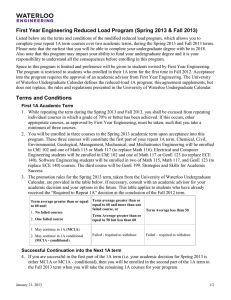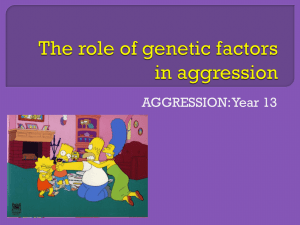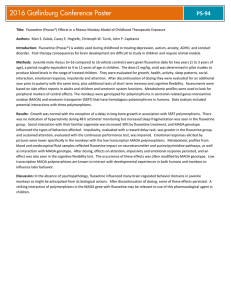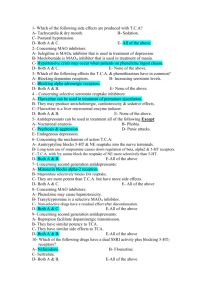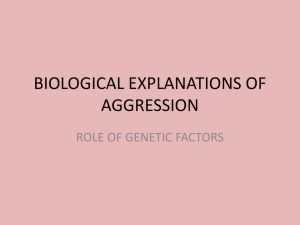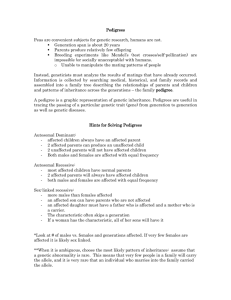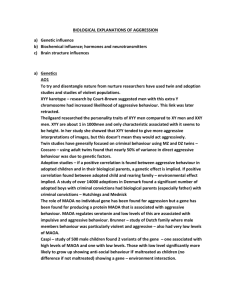Nature vs. Nurture: Behavioral Genetics and the Law
advertisement
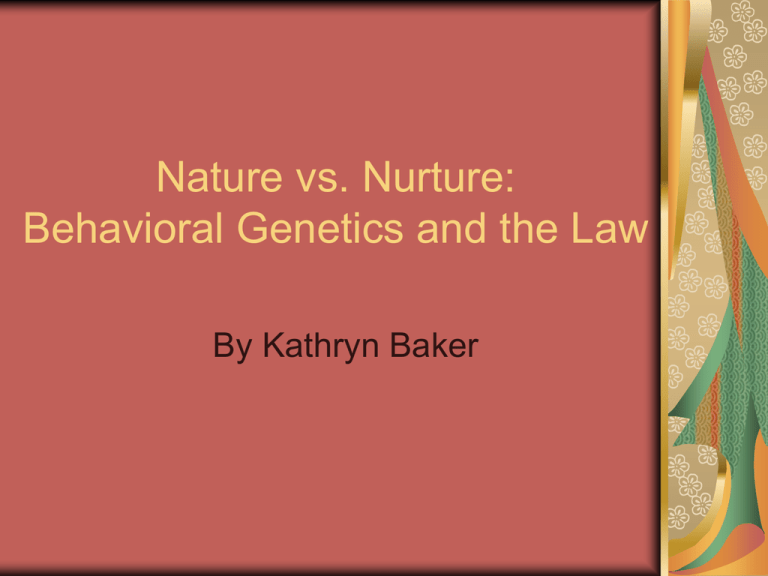
Nature vs. Nurture: Behavioral Genetics and the Law By Kathryn Baker The Gene x Environment Interaction The formula for how genetics and life experiences influence a person Many professionals believe that violent behavior is linked to a person’s life experiences Research is being done on many fronts to help the courts deal with new discoveries regarding the human genome and how it affects behavior What is MAOA? Monoamine Oxidase A – a gene on the X chromosome; codes for MAOA enzyme which, when there are low amounts, inactivates neurotransmitters like norepinephrine, serotonin, and dopamine Linked to the prevalence of anti-social and aggressive behavior in males who were maltreated as children The Dunedin Study: Testing the Effects of MAOA Hypothesis: “that MAOA genotype can moderate the influence of childhood maltreatment on neural systems implicated in antisocial behavior” Participants (3-11 years of age): 8% severely maltreated as children, 28% probable maltreatment, 64% no maltreatment Psychological assessment at age 26 Summary of some results: Males with high levels of MAOA activity were less affected by childhood maltreatment Conduct disorder more common among maltreated males with low levels of MAOA activity Violent crime convictions more common among maltreated males with low levels of MAOA activity The Numbers Approximately 80% of maltreated males with low levels of MAOA activity were reported to have conduct disorder Approximately 40% of maltreated males with high levels of MAOA activity were reported to have conduct disorder Maltreated males with low levels of MAOA activity made up 12% of the group BUT they accounted for 44% of the group’s violent crime convictions 85% of maltreated males with low levels of MAOA activity developed antisocial behaviors Court Cases Mobley v. State (1994): Mobley convicted of murder, armed robbery, aggravated assault and possession of a firearm; wanted evidence presented that said he had deficient MAOA activity; denied because it “lacked scientific verifiability sufficient for it to be introduced;” executed on March 1, 2005 State v. Sanders: the “serotonin defense;” low levels of serotonin led to an inability to control impulsive behavior; denied during trial because “It could not determine that… he lacked the specific intent to kill… only demonstrates that he was enraged when he did;” accepted during sentencing – sentenced to life without parole Court Cases Continued State v. Payne: expert testimony introduced about Payne’s low levels of serotonin which suggested that he could not “control [an] impulse once it had occurred;” jury found Payne guilty of seconddegree rather than first-degree murder (Payne was also under the influence of cocaine and alcohol at the time of the crime) What is SLC6A4? The serotonin transport gene Short allele causes low transport activity – the serotonin system is inefficient Low levels of activity could lead to depression in some individuals Genotyping Defendants AA: High activity MAOA, short SLC6A4 allele; expert testified AA had a “genetic vulnerability to become depressed under severe stress;” found guilty of first-degree murder BB: High activity MAOA; long SLC6A4 allele; expert testified that there were “no genetic factors” that “might predispose BB to violence;” nobody objected to this testimony DD: High activity MAOA; heterozygous for SLC6A4; court suggested that genetic testing could become necessary component of defense FF: High activity MAOA; short SLC6A4 allele; court decided behavioral genetics was “not yet scientific enough to present as testimony before a jury” Implications and Questions Is this a sound defense against the death penalty: A “person should not receive the death penalty because his behavior was at least partly caused by his genetic makeup and his adverse life experiences”? What about personal responsibility? The redefinition of “normal.” Does anyone who is “normal” commit a violent crime? Does every criminal have a genetic disorder – will they in the future? Is evidence of genetic and behavioral interaction acceptable for defending the insanity defense? Not guilty by reason of insanity vs. Guilty but mentally ill. What types of punishment become acceptable? Resources Caspi, Avshalom et al. “Role of Genotype in the Cycle of Violence in Maltreated Children.” Science Vol. 297, 2002. Bernet, William et al. “Bad Nature, Bad Nurture, and Testimony regarding MAOA and SLC6A4 Genotyping at Murder Trials.” J Forensic Science Vol. 52, No. 6, 2007.


